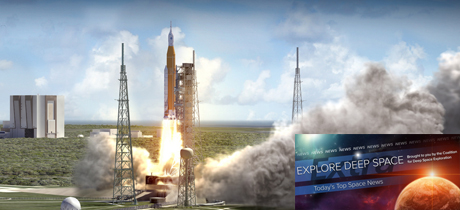In Today’s Deep Space Extra… Efforts to expand human activities in low Earth orbit as well as deep space are likely to require NASA’s Space Launch System (SLS) as well as the best in new propulsion from the commercial space industry. But a debate is under way. Confronting space debris could be a national security challenge. In Florida, NASA’s next planet seeking mission, the Transiting Exoplanet Survey Satellite, is being prepped for an April liftoff.
Human Space Exploration
Don’t abandon NASA-led legacy systems
USA Today (2/26): Though impressive, recent commercial accomplishments like the inaugural launch of SpaceX’s Falcon Heavy do not diminish the promise of NASA’s Space Launch System (SLS), writes Chris Carberry, the CEO of Explore Mars, Inc. Unless proven alternatives emerge, NASA systems are likely to offer unmatched capabilities to achieve ambitious space objectives, such as reaching new deep space destinations with human explorers. Carberry’s views are counter to those of a USA Today editorial (https://www.usatoday.com/search/NASA/), which contends NASA has over invested in the Space Launch System (SLS) and that the Falcon Heavy could be a less expensive alternative.
Why technological innovation and increased cooperation regarding space debris are vital
The Space Review (2/26): Growing numbers of advanced technologies are being focused in the issue of orbital space debris, whose population is growing as the numbers of space actors and their activities increase. Unchecked, the growth could lead to collisions and unwanted chain reactions, the Kessler effect. Unless carefully managed, however, efforts to mitigate space debris could become a security issue. Analyst and author Nayef Al-Rodhan surveys the technologies and ponders who, perhaps the U.N., could play a role in regulating efforts to stem the threat to low Earth orbit space activities.
Space Science
New NASA planetary protection officer seeks greater cooperation with human and commercial missions
Space News (2/26): Changes in approach by NASA’s planetary protection office will make it a resource for advice as well as an enforcer of protective measures to government and commercial mission personnel targeting deep space destinations, where they could risk terrestrial contamination. The same measures apply to missions returning to Earth with samples of materials from distant planetary objects with potential extraterrestrial contaminants. Lisa Pratt, NASA’s new planetary protection officer, addressed the topic before the agency’s Planetary Science Advisory Committee on February 22
Researchers recreate clay minerals found on Mars
Seeker.com (2/23): Scientists at the University of Nevada/Las Vegas have succeeded in recreating Martian clay simulants in a laboratory. The findings, based on discoveries by NASA’s Curiosity rover at Gale Crater on Mars, may explain why organic materials associated with possible life on Mars do not last long. That could make finding evidence for past life on the Red Planet more difficult.
Inside the clean room: NASA’s exoplanet-hunter TESS gets prepped for launch
Space.com (2/26): Slated for launch in April, NASA’s Transiting Exoplanet Survey Satellite (TESS) awaits an opportunity to seek out more planets beyond the solar system. Like its predecessor, the Kepler space telescope, TESS is designed to detect planets as they cross in front of and dim the light beaming from stars in the Milky Way. TESS will have a much larger field of view than does Kepler. Astronomers expect to follow up discoveries from TESS with observations using the James Webb Space Telescope, which is to launch in the spring of 2019.
Universe Today (2/26): The joint European and U.S. Solar Heliospheric Observatory mission, also known as SOHO, has been a scientific gem. Launched in 1995 on a three year mission, the spacecraft is still working after more than two decades, revealing the inner workings of the sun and its far reaching impact on the Earth and rest of the solar system.
Other News
SpaceX delays next Falcon 9 rocket launch to conduct nose cone checks
Space.com (2/24): SpaceX’s launching of Hispasat 30W-6, a Spanish communications satellite, planned for last Sunday from Cape Canaveral Air Force Station, Florida, has been delayed while the company checks the payload fairing. SpaceX may have to wait for United Launch Alliances scheduled launch Thursday of a new NOAA/NASA geosynchronous weather satellite from Cape Canaveral.
Cape Canaveral could see two launches in one day
Coalition Member in the News – United Launch Alliance
Spaceflightnow.com (2/27): Cape Canaveral Air Force Station, Florida, may be the site for a pair of rocket launches on Thursday due to an upgrade in range safety technologies and procedures in effect on the U.S. Air Force Eastern Range. Because of prior launch scheduling the day’s priority falls to NOAA’s GOES-S weather satellite, which is to launch atop an Atlas 5 rocket during a two hour launch window that opens at 5:02 p.m., EST. If SpaceX can resolve a payload fairing concern, a Falcon 9 rocket with the Spanish Hispasat communications satellite could launching during a two hour window that opens at 12:34 a.m., EST. A new automated range safety system mechanism is making the faster launch pace possible.
Making space regulations great again
Coalition Member in the News – United Launch Alliance
The Space Review (2/26): As the White House National Space Council (NSC) gathered at NASA’s Kennedy Space Center last week for its second meeting since being re-established last year, Vice President Mike Pence, the NSC’s chair, offered assurances the U.S. leads the world in space and will continue to forge ahead with a the help of a new Users Advisory Group. Pence called for a range of regulatory reforms intended to add muscle from the nation’s commercial space sector to help fuel a surge in space activity.
Reconnaissance satellite launched by Japanese H-2A rocket
Spaceflightnow.com (2/27): A Japanese H-2A rocket launched Tuesday with a reconnaissance satellite, whose targets are to include missile developments in North Korea.

